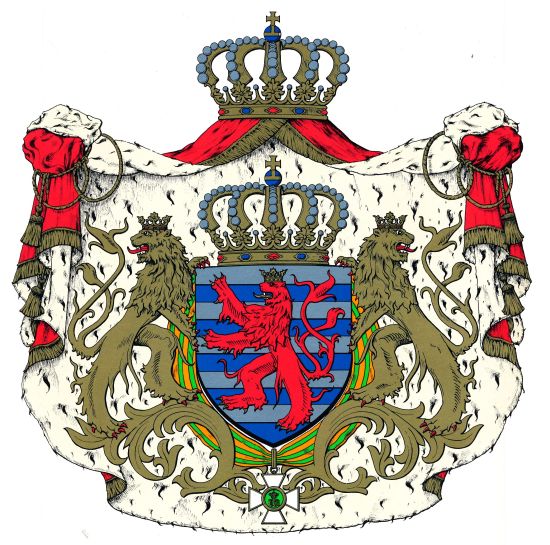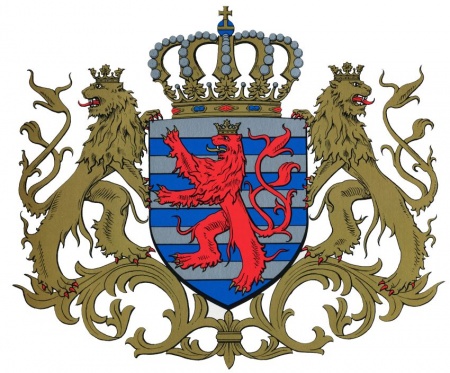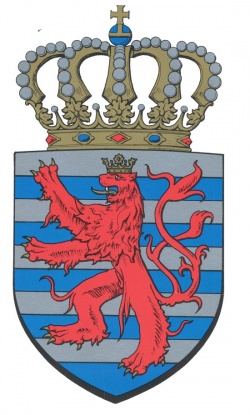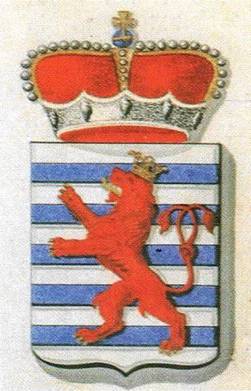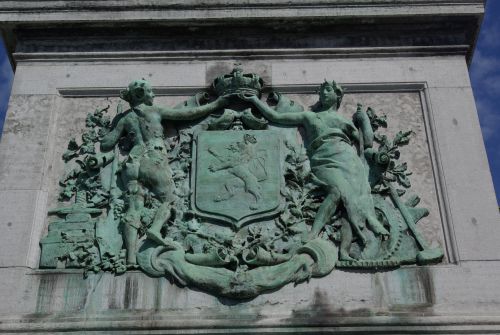The National Arms of Luxembourg
| Heraldry of the World |
| Luxembourg heraldry portal Héraldique de Luxembourg Luxemburgische Wappen |
|
THE NATIONAL ARMS OF LUXEMBOURG
Official blason
a) petites armoiries: Burelé d'argent et d'azur de dix pièces au lion rampant de gueules, couronné, armé et lampassé d'or, la queue fourchue et passée en sautoir. Timbre: La couronne grand-ducale non doublée. b) moyennes armoiries: Les petites armoiries augmentées des supports: Deux lions d'or et couronnés du même, la tête contournée (regardants), armés et lampassés de gueules, la queue fourchue et passée en sautoir. c) grandes armoiries: Les moyennes armoiries augmentées du ruban et de la croix de l'Ordre national de la couronne de chêne passés autour de l'écu; le tout posé sur un manteau: de gueules doublé d'hermine, bordé, frangé, cordonné et houppé d'or, sommé de la couronne grand-ducale non doublée.
Origin/meaning
The arms were officially adopted first on October 5, 1817, again on November 17, 1868 and finally on June 23, 1972.
There are greater, middle and lesser versions of the coat of arms of Luxembourg. The greater coat of arms, shown above, has two reguardant and crowned lions as supporters, the Dynastic Order (the Order of the Oak Crown) and all surrounded by hermine mantling crowned with a heraldic royal crown (the crown used by the Grand Duke). The middle coat of arms has the supporters, the order and the crown. The lesser coat of arms has the crown and the escutcheon without external ornaments.
| The middle arms |
The small arms |
At the end on the 12th century the County of Luxembourg was ruled by the Counts of Limburg. The coat of arms of Limburg was a red lion in silver. As rulers of Limburg and Luxembourg, the lion probably became double tailed.
The oldest use of the double-tailed lion with the blue bars dates from a seal on a document dated May 2, 1242. Henry IV was at the time the ruler of Luxembourg and probably added the blue bars to distinguish his arms with those from his father. `
| The seal from 1242 (State Archives, Liège) |
The colours are first mentioned in the Bigot Roll of Arms (1254) as barry of silver and blue with a red , gold crowned lion rampant.
The arms basically never changed, only after 1262 the lion changed direction as compared to the old 1242 seal where the lion faces left.
The number of bars, on the other hand, was not very constant during the years. It ranges from sixteen under Henry VI to four under Philip the Fair. From the beginning of the fifteenth century, the number gradually began to stabilize to ten.
For nearly four centuries, Luxembourg was governed together with the Netherlands, after 1581 with the Southern Netherlands. A French occupation from 1678 to 1698 was only a brief interruption. The break-up of the administrative association was announced by the decision of the Vienna Congress in 1815 to raise Luxembourg to a Grand Duchy in personal union with the Kingdom of the Netherlands. King William I, however, actually controlled the Grand Duchy as a province of the Netherlands. He therefore did not have a separate Grand Ducal coat of arms. Luxembourg had to be content to be confirmed in the use of the traditional coat of arms granted by letter dated 18 November 1818, albeit with the official addition of a ducal crown.
| The arms of 1818 (Hoge Raad van Adel, Den Haag) |
In 1830, Luxembourg joined the Belgian Revolt. Nine years later, the great powers decided to split the Grand Duchy. The Walloon part was incorporated into Belgium as the province of Luxembourg. A coat of arms for this part had already been adopted by the decree of the king of Belgium on 17 May 1837.
The eastern part remained in personnel union with the Netherlands but with a separate status. For this part, the coat of arms of 1818 was used , although the crown now had five leaves, four pearls and five arches. Presumably by Prince Henry, who ruled the Grand Duchy as a stadholder in the name of his brother, King William III, from 5 February 1850, two crowned lions were added to the coat of arms to make an achievement.
Until 1972 the country itself did not have official national arms. In practice the old arms from 1850 were used, but never formally adopted. The Grand-Dukes themselves used different variations of the Luxembourg arms with the arms of the House of Nassau. In 1972 also the difference between the great arms, the middle and the small arms were described.
The arms of the city of Luxembourg uses very similar arms, but with a different number of bars.
| The arms on a monument in Luxembourg city (2013) |
Contact and Support
Partners:
Your logo here ?
Contact us
© since 1995, Heraldry of the World, Ralf Hartemink 
Index of the site
Literature : Loutsch, 1989; Official brochure, 1972


